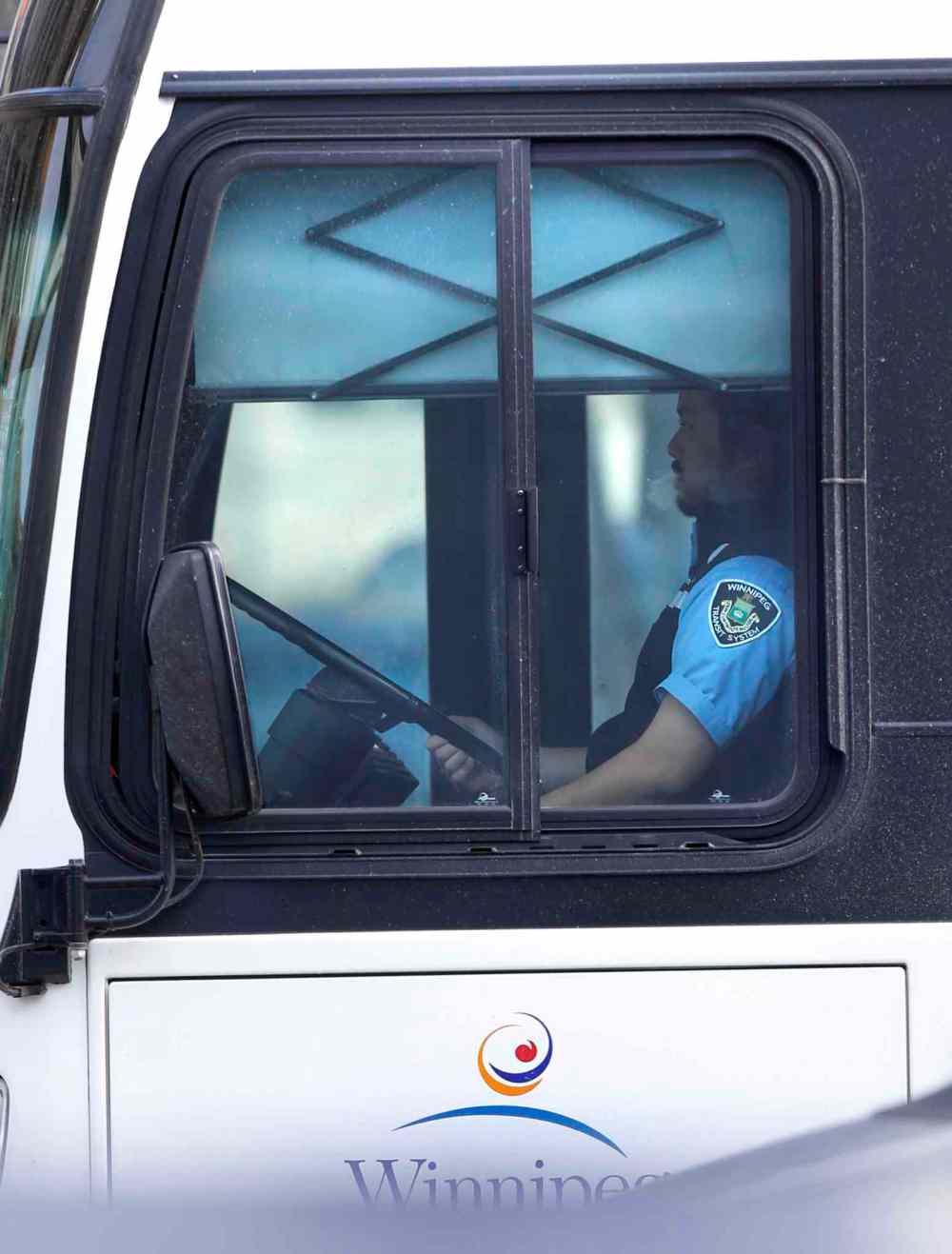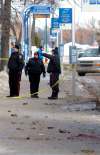Transit safety a longtime concern and drivers want action
'How many crazies are out there that I just let on the bus?'
Advertisement
Read this article for free:
or
Already have an account? Log in here »
To continue reading, please subscribe:
Monthly Digital Subscription
$0 for the first 4 weeks*
- Enjoy unlimited reading on winnipegfreepress.com
- Read the E-Edition, our digital replica newspaper
- Access News Break, our award-winning app
- Play interactive puzzles
*No charge for 4 weeks then price increases to the regular rate of $19.00 plus GST every four weeks. Offer available to new and qualified returning subscribers only. Cancel any time.
Monthly Digital Subscription
$4.75/week*
- Enjoy unlimited reading on winnipegfreepress.com
- Read the E-Edition, our digital replica newspaper
- Access News Break, our award-winning app
- Play interactive puzzles
*Billed as $19 plus GST every four weeks. Cancel any time.
To continue reading, please subscribe:
Add Free Press access to your Brandon Sun subscription for only an additional
$1 for the first 4 weeks*
*Your next subscription payment will increase by $1.00 and you will be charged $16.99 plus GST for four weeks. After four weeks, your payment will increase to $23.99 plus GST every four weeks.
Read unlimited articles for free today:
or
Already have an account? Log in here »
Hey there, time traveller!
This article was published 15/02/2017 (3224 days ago), so information in it may no longer be current.
Protective shields for drivers? More police officers assigned to ride the bus?
Safety was top of mind across Winnipeg in the aftermath of the gruesome overnight stabbing Tuesday that killed a longtime Transit driver and sent a chill through the bus service’s ranks, their union and on the University of Manitoba campus, where the attack occurred.
“How many crazies are out there that I just let on the bus?” said a distraught Nelson Giesbrecht, a friend and colleague of the victim, 58-year-old Irvine Jubal Fraser.
Safety was a priority issue during 2015 collective-bargaining talks between the city and the union representing Transit drivers, Giesbrecht said.

But nothing of substance came after a committee was formed to study the issue and letters were exchanged among that group, the union and city hall, said Giesbrecht, a driver for 19 years.
“I don’t see where it’s gotten us. Now a guy’s dead,” he said adding Fraser’s death has ratcheted up fears. “I don’t know; It’s not getting better.”
Among other drivers, there was anger mixed with sorrow.
“Maybe now they will finally do something,” said a 14-year Transit operator who didn’t want his name published. “Too bad it had to come to this.”
He said he’s been assaulted on the job twice in the past decade.
“The only concern is: are the passengers OK? Then, carry on. That’s how it is done.”
It’s no secret there are long-standing safety concerns among drivers, a 12-year Transit veteran said during a smoke break.
“It’s been a long time we’ve been telling (Transit): the late-night drivers are not safe enough,” he said. “I hope the union will wake up. There has been some (talk) but it’s just verbal. Everything is just words.”
Mayor Brian Bowman, acknowledging bus safety has been an ongoing issue, said no measures should be implemented until the police have completed their investigation into Tuesday’s horror.
“We’ll continue to have that conversation, but we’ll benefit from having the facts on the table as it relates specifically to this incident,” he told reporters.
Winnipeg Transit and the Amalgamated Transit Union Local 1505 discussed the installation of protective shields for drivers a few years ago, but jointly decided not to move ahead, said Dave Wardrop, the city’s new Chief Transportation and Utilities Officer and the former Transit director.
That option will be revisited, he said.
“We’ll be examining all options and all alternatives going forward… the top priority for me now is (to) look at what we can do to improve safety and security, to work collaboratively with (the union) and to ensure the well-being of our employees is in place to the extent it can be.”
Wardrop said there are several emergency and safety features on all transit buses, including four or five security cameras, the number depending on the size of the bus, and emergency alarms.
A review of Transit safety issues conducted in 2013 examined measures other cities’ transit agencies implemented. That led to the city hiring six safety inspectors to deal with unruly passengers in 2014. In 2016, the city agreed to deploy an additional unspecified number of uniformed and undercover police officers to ride on routes identified as troublesome by the bus service.
Wardrop would not say how often inspectors and police are riding, adding the number would be dependent on available resources and scheduling.
“(The attack is) obviously a very disturbing incident but it’s not part of a trend,” said St. Vital Coun. Brian Mayes, an advocate of greater bus safety. “We have been looking at this issue. We have taken some concrete action… but maybe it’s time to take another review.”
Reported assaults on Winnipeg Transit drivers went up from 54 per cent from 2014 to 2015 — to 60 attacks from 39, the union local reported previously. Some assaults were verbal but others were serious attacks. Two-thirds revolved around fare disputes.
The violent incidents are way up from a decade ago. In 2005, there were just 17 reported assaults, and that was consistent for the previous five years.
But John Callahan, Local 1505 ATU president, said putting uniformed and plainclothes officers on Winnipeg buses has had a significant impact on safety. The number of reported assaults dropped to 45 in 2016.
“It’s definitely made a difference,” he said. “We’ve had reports from our membership of almost three dozen police interventions that could have escalated into assaults.”
One driver said he understands the reality that there will never be money, staff and political will to put a police officer on every bus, the idea that one might be there acts as a deterrent.
“Put it in peoples’ minds: is one of these passengers police?”
Paul Thorp, president of ATU Canada, called the slaying “a senseless tragedy.”
“We’re hoping management and the union will discuss new procedures to keep drivers safe… it’s unfortunate something like this has to happen before we talk about keeping people safe.”
Thorp said he hopes whatever additional safety measures are implemented here also help transit operators across the country.
“We have countless assaults that happen on a daily basis,” he said. Every working person in Canada and the United States expects to go to work not fearing for their lives. We want them to get home safely.”
Thorp said the federal government passed an amendment to the Criminal Code in 2015 requiring courts to consider attacks on transit operators an aggravating factor for sentencing, but so far judges haven’t been applying it.
Federal Public Safety Minister Ralph Goodale has long been a proponent of tougher sentences for people who assault transit drivers, introducing a private members bill while in opposition in 2013 that would require judges use the fact a victim worked for a transit system as an aggravating circumstance during sentencing.
His bill didn’t pass but a similar one from Conservative Senator Bob Runciman did in Feb. 2015, and Goodale said he supported that. That law, commonly known as Bregg’s Law, is named after Edmonton transit driver Tom Bregg, who was assaulted to the point of suffering brain injuries and losing the sight in one eye.

Bregg was assaulted by a drunken man who refused to pay the far. The man stomped on Bregg’s face several times, leaving him so injured he was in hospital for more than eight weeks.
Gary Mattson later pleaded guilty to aggravated assault and was declared a dangerous offender.
“We all need to examine the law to make sure that it’s as strong as it can be in dealing with circumstances of this kind,” Goodale said Tuesday.
The University of Manitoba Students’ Union said it would advocate for more safety measures on campus.
“Student safety is our No. 1 concern,” said president Tanjit Nagra.
“The incident that occurred last night is extremely terrible,” she said. “If anything, this is an indication that our students need to be safe, especially when riding the bus later at night.”
An international student living on campus said he doesn’t have a car, so the bus is his only option for getting around.
“I don’t feel secure to take it alone now,” he said.
Transit drivers were clear on one thing Tuesday. Safety must be improved.
“We hope so… we lost someone. It’s not like an assault when you can recover,” one said. “This one is gone.”
Story includes files from: Ashley Prest, Mike McIntyre, Bill Redekop, Aldo Santin, Boris Minkevich, Mia Rabson, Kevin Rollason and Scott Emmerson






